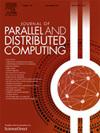边缘度量基础及其在一定互连网络中的容错性
IF 3.4
3区 计算机科学
Q1 COMPUTER SCIENCE, THEORY & METHODS
引用次数: 0
摘要
互连网络中元素的监控是计算机工程中的一个经典问题。此外,它是一个与唯一识别网络元素密切相关的问题,这确实是图论中一个经典的与距离相关的问题。这种监视可以考虑网络中不同风格的元素。经典版本将注意力集中在节点上,而最近的一些变化则考虑同时监控边缘或同时监控顶点和边缘。第一种方法产生了称为边缘分辨集和边缘度量基的图结构,它们通过距离向量来唯一地识别给定网络的边缘。如果dG[e,x]≠dG[f,x],则图G中的顶点x唯一地识别(或识别)G中的两条边e和f,其中dG[e,x]表示顶点x与G中的边e之间的距离,使得S中每一对边都被S中至少一个顶点唯一识别的集合S是边度量基,一个工作系统的容错能力是指即使其中一个部分停止正常工作,该系统仍能保持正常工作的能力。本文考虑了边缘度量基的容错特性。这就产生了容错边缘度量基的概念。即,如果图G的每一对边都被S中的至少两个顶点解析,则图G的边度量基S是容错的,并将这些集合的最小可能基数称为G的容错边度量维数。本文给出了图的边度量维数及其容错版本的界限。此外,我们研究了蝴蝶网络、贝内斯网络和分形三次网络的这些参数,并找到了它们(容错)边缘度量维的精确值。本文章由计算机程序翻译,如有差异,请以英文原文为准。
Edge metric basis and its fault tolerance over certain interconnection networks
The surveillance of elements in an interconnection network is a classical problem in computer engineering. In addition, it is a problem closely related to uniquely identifying the elements of the network, which is indeed a classical distance-related problem in graph theory. This surveillance can be considered for different styles of elements in the network. The classical version centers the attention on the nodes, while some recent variations of it consider monitoring also the edges or both, vertices and edges at the same time. The first style gave rise to graph structures, called edge resolving set and edge metric basis, which is used to uniquely identify the edges of a given network by means of distance vectors. A vertex x in a graph G uniquely recognizes (resolves or identifies) two edges e and f in G if , where stands for the distance between a vertex x and an edge e of G. A set S with the smallest number of vertices, such that every couple of edges is uniquely recognized by a minimum of one vertex in S, is an edge metric basis, and the edge metric dimension refers to the cardinality of such S. Fault tolerance of a working system is the ability of such a system to keep functioning even if one of its parts stops working properly. The fault tolerance property of the edge metric basis is considered in this work. This results in a concept called fault-tolerant edge metric basis. That is, an edge metric basis S of a graph G is fault-tolerant if every pair of edges of G are resolved by a minimum of two vertices in S, and the minimum possible cardinality of such sets is coined as the fault-tolerant edge metric dimension of G. In this work, we present bounds for the edge metric dimension of graphs and its fault tolerance version. In addition, we investigate these parameters for butterfly, Beneš and fractal cubic networks, and found the exact value for their (fault-tolerant) edge metric dimensions.
求助全文
通过发布文献求助,成功后即可免费获取论文全文。
去求助
来源期刊

Journal of Parallel and Distributed Computing
工程技术-计算机:理论方法
CiteScore
10.30
自引率
2.60%
发文量
172
审稿时长
12 months
期刊介绍:
This international journal is directed to researchers, engineers, educators, managers, programmers, and users of computers who have particular interests in parallel processing and/or distributed computing.
The Journal of Parallel and Distributed Computing publishes original research papers and timely review articles on the theory, design, evaluation, and use of parallel and/or distributed computing systems. The journal also features special issues on these topics; again covering the full range from the design to the use of our targeted systems.
 求助内容:
求助内容: 应助结果提醒方式:
应助结果提醒方式:


